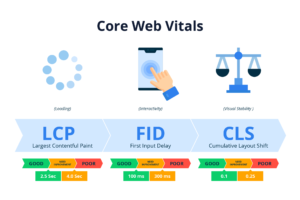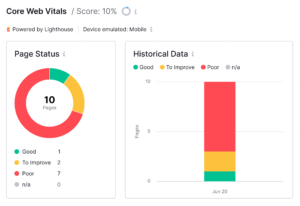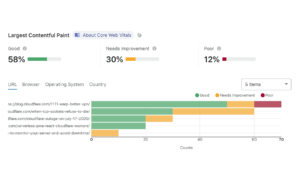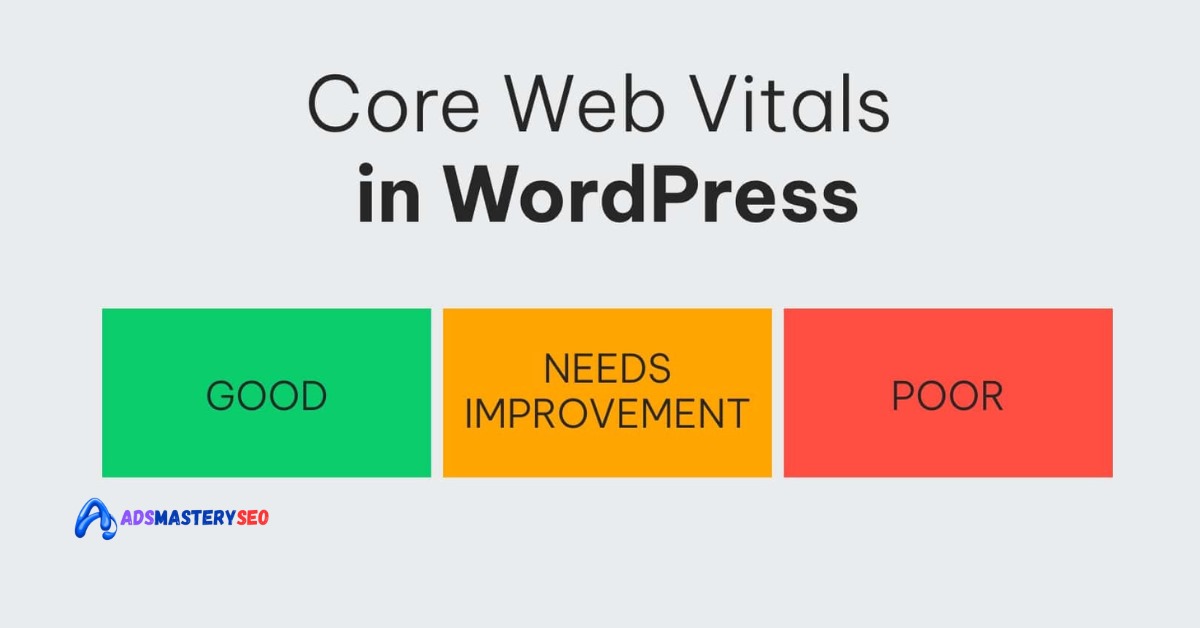Introduction
Agree
In today’s digital world, website speed, interactivity, and users experience (UX) play a crucial role in online success. User expect fast, seamless browsing, and Google rewards website that meet these expectations.
Amplify
Google has always prioritized user experience (UX) in its ranking factors, but with Core Web Vitals, it now has clear, measurable metrics to assess website performance. These three key metrics-Largest Contentful Paint (LCP), First In Delay (FID), abd Cumulative Layout Shift (CLS)-help webmasters create a faster, smoother, and more engaging experience. Not only does this improve search ranking, but it also boosts user satisfaction, lower bounce rates, and higher conversions.
Preview
In this article, we’ll break down Core Web Vitals, explain why they matter, and show how they directly impact website performance and UX. Plus, we’ll cover practical steps to optimize these vitals, ensuring your site meets Google’s standards for ranking success.
Let’s dive in! 🚀
1. What Are Google’s Core Web Vitals?
 Core Web Vitals are a set of three specific performance metrics that measure user experience on a webpage. Google introduced them to quantity UX factors that directly affect how users interact with a website.
Core Web Vitals are a set of three specific performance metrics that measure user experience on a webpage. Google introduced them to quantity UX factors that directly affect how users interact with a website.
The Three Core Web Vitals:
i. Largest Contentful Paint (LCP) – Measures Loading Speed
- LCP refers to how long it takes for the largest visible content (image, text, or video) to load.
- A good LCP score is under 2.5 seconds.
- Impact: If your website takes too long to load, user may abandon it before interacting, leading to high bounce rates.
ii. First Input Delay (FID) – Measures Interactivity
- FID measures the time it takes for a user’s first interaction (like clicking a button or link) to respond.
- A good First Input Delay score is less than 100 milliseconds.
- Impact: A Slow response time frustrates users, leading to poor engagement and lost conversions.
iii. Cumulative Layout Shift (CLS) – Measures Stability of Vision (Adsmasteryseo)
- CLS tracks unexpected shifts in a webpage’s layout while loading.
- A good CLS score is below 0.1.
- Impact: If elements move unexpectedly, users might click the wrong buttons, leading to frustration and a bad UX
2. Why Do Core Web Vitals Matter?
Google’s Core Web Vitals are very important because they:
✔️ Improve Search Rankings – Since May 2021, Core Web Vitals are ranking factors in Google’s algorithm. Websites that meet these standards rank higher.
✔️ Enhance User Experience – Faster, more stable websites provide a smooth, frustration-free experience, increasing user retention.
✔️ Reduce Bounce Rate – If a page loads too slowly, users leave before interacting. Faster sites keep visitors engaged longer.
✔️ Boost Conversions & Revenue – A 1-second delay in page load time reduces conversions by 7%. Optimizing Core Web Vitals leads to higher engagement and sales.
✔️ Google’s Mobile-First Focus – With more than 60% of searches happening on mobile, Google prioritizes fast, responsive sites that work well on smartphones.
3. How Google’s Core Web Vitals Improve Websites Performance & UX

i. Faster Loading Speed (LCP Optimization)
- Optimized Images: Use next-gen formats (WebP, AVIF) to reduce file size without sacrificing quality.
- Efficient Server Response: Use a fast hosting provider and implement caching (CDN, browser caching) to serve pages quicker.
- Reduce JavaScript & CSS Bloat: Minify and compress scripts to ensure faster loading times.
ii. Improved User Interaction (FID Optimization)
- Reduce JavaScript Execution:Eliminate unnecessary JavaScript and use asynchronous loading to improve interaction time.
- Minimize Third-Party Scripts:Reduce external scripts (ads, analytics) that slow down user interaction.
- Implement Lazy Loading:Defer loading of images and videos until they’re needed to speed up page response.
iii. Stable Visual Layout (CLS Optimization)
- Define Image & Video Dimensions:Specify height and width for all media elements to prevent unexpected layout shifts.
- Use Font Display: Swap:Load text faster by allowing fallback fonts while custom fonts are still loading.
- Optimize Ads & Embeds:Ensure ad slots and embedded content don’t push visible elements around.
4. Tools to Measure & Improve Core Web Vitals
 Google provides free tools to analyze and optimize Core Web Vitals:
Google provides free tools to analyze and optimize Core Web Vitals:
- Google PageSpeed Insights -Provides detailed Core Web Vitals scores and recommendations.
- Google Lighthouse – Offers an in-depth audit of performance, SEO, and accessibility.
- Chrome DevTools – Helps developers debug performance issues directly in the browser.
- Google Search Console (Core Web Vitals Report) – Monitors site-wide performance for ranking improvements.
Regularly testing your website ensures it meets Google’s UX standards, leading to better rankings and user satisfaction.
5. The Future of Core Web Vitals & Google’s UX-Focused Strategy
Google is constantly refining Core Web Vitals to improve online user experience. Some upcoming changes and trends include:
- Interaction to Next Paint (INP) Replacing FID: Google plans to introduce INP in 2024, providing a more accurate measure of responsiveness beyond FID.
- Expanded Mobile-First Indexing: Google will prioritize mobile performance even more in future updates.
- AI & Machine Learning Enhancements: Google’s AI will continue to prioritize high-quality, user-friendly sites.
Staying ahead of these trends ensures your website remains optimized for both users and search engines.
6. Mobile Optimization: Core Web Vitals for a Mobile-First World
With over 60% of global searches happening on mobile devices, Google has adopted a mobile-first indexing approach, meaning mobile performance directly impacts ranking. Core Web Vitals play a crucial role in ensuring a smooth and fast mobile experience.
How Core Web Vitals Improve Mobile Performance:
- Faster Loading Speeds (LCP Optimization for Mobile) – Mobile networks are often slower than Wi-Fi, so optimizing images compression, server response times, and caching is crucial.
- Better Interactivity (FID for Touchscreen Responsiveness) – User expect fast responses when tapping buttons, so reducing JavaScript execution time ensures instant interactions.
- Stable Layouts (CLS to Prevent Unintended Clicks) – Unexpected layout shifts are even more annoying on mobile due to smaller screens. Optimizing font loading, ad placement, and image sizes prevents frustrating misclicks.
Best Practices for Mobile Core Web Vitals Optimization:
- User Responsive Design – Ensure your site adapts seamlessly to different screen sizes.
- Enable AMP (Accelerated Mobile Pages) – Google’s AMP framework speed up page loading times.
- Minimize Mobile Pop-ups & Intrusive Ads – Google penalizes sites with disruptive mobile ads that negatively impact UX.
Why Mobile Optimization Matters:
✔️ Google ranks mobile-friendly sites higher 📊
✔️ Users expect a fast, seamless browsing experience 📱
✔️ A well-optimized mobile site leads to higher engagement and conversions 🎯
“By focusing on Core Web Vitals for mobile, you’ll get a better experience for users and improved search rankings.”
7. Long-Term SEO Benefits of Core Web Vitals Optimization
Optimizing Core Web Vitals isn’t just about better performance today-it’s about future-proofing your website for long-term SEO success.
How Core Web Vitals Help Your SEO Strategy:
- Higher Rankings & Visibility – Google prioritizes fast, user-friendly sites, giving them a competitive edge.
- Better Crawl Efficiency – Faster sites help Google crawl and index pages more effectively, improving SEO.
- Reduced Bounce Rate & Higher Engagement – Sites that load quickly keep visitor engaged longer, leading to better behavioral signals for Google.
- Competitive Advantage Over Slow Sites – As Google tightens UX ranking factors, slow site will struggle to rank, while optimized sites will continue to grow faster.
Long-Term Optimization Strategies:
- Regularly Monitor Core Web Vitals Using Google Search Console – Track performance metrics and fix issues before they affect rankings.
- Stay Updated on Google Algorithm Changes – Google constantly updates ranking factors that makes ranking faster, and UX will always remain a priority.
- Invest in High-Quality Hosting & CDNs – Faster server response times boost LCP and overall site speed.
The Bottom Line:
By making Core Web Vitals a core part of your SEO strategy, you ensure long-lasting improvements in both rankings and user satisfaction. Sites that prioritize speed, interactivity, and stability will always have an advantage in Google Search results.
Conclusion: Why You Must Optimize for Core Web Vitals
Google’s Core Web Vitals are not just another ranking factor-they are essential for providing a smooth, high-quality user experience. By focusing on loading speed (LCP), interactivity (FID), and stability (CLS), websites can:
✅ Rank higher in search results
✅ Deliver a better UX, leading to more engagement
✅ Reduce bounce rates and increase conversions
✅ Future-proof their websites for Google updates
Want to optimize your website’s Core Web Vitals for better ranking and UX?
Visit AdsMasterySeo.com for expert tips and guides!
We are gathering data by our daily research. We are working just for solving your problems facing in wordpress website, SEO or Google AdSense. Google AdSense provide a chance to earn money worldwide. We are working to help you to get AdSense approval legally by Google’s Policies. Our team research data according to your need, we check your comments and massages to make a solution for your problem. So if you’re facing any problem in your site let us know by commenting or contacting us. Thank You!
We are available 24/7 hours. So If you want to discuss about your website problems with us and want us to design your websites than just send a text to us on Our Contact Us page we’ll reach you as soon as possible. We’ll guide you as per your query. We hope that you will satisfy with our team.
Keep visiting our site to get up to date with our updates. We’re collecting data just for your help.
